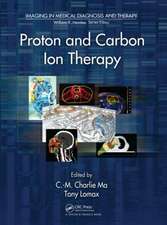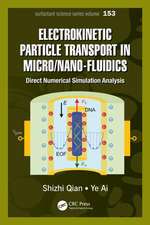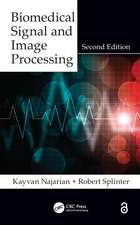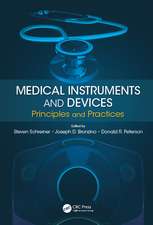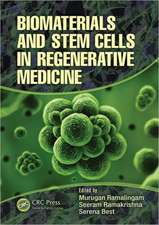Complex Systems in Biomedicine
Editat de A. Quarteroni, L. Formaggia, A. Venezianien Limba Engleză Hardback – iun 2006
| Toate formatele și edițiile | Preț | Express |
|---|---|---|
| Paperback (1) | 697.47 lei 6-8 săpt. | |
| Springer – 21 oct 2010 | 697.47 lei 6-8 săpt. | |
| Hardback (1) | 571.89 lei 38-44 zile | |
| Springer – iun 2006 | 571.89 lei 38-44 zile |
Preț: 571.89 lei
Preț vechi: 706.04 lei
-19% Nou
Puncte Express: 858
Preț estimativ în valută:
109.44€ • 118.84$ • 91.93£
109.44€ • 118.84$ • 91.93£
Carte tipărită la comandă
Livrare economică 18-24 aprilie
Preluare comenzi: 021 569.72.76
Specificații
ISBN-13: 9788847003941
ISBN-10: 8847003946
Pagini: 308
Ilustrații: XIV, 292 p.
Dimensiuni: 210 x 279 x 22 mm
Greutate: 0.71 kg
Ediția:2006
Editura: Springer
Colecția Springer
Locul publicării:Milano, Italy
ISBN-10: 8847003946
Pagini: 308
Ilustrații: XIV, 292 p.
Dimensiuni: 210 x 279 x 22 mm
Greutate: 0.71 kg
Ediția:2006
Editura: Springer
Colecția Springer
Locul publicării:Milano, Italy
Public țintă
Professional/practitionerCuprins
Inverse problems in biomedical imaging: modeling and methods of solution.- Stochastic geometry and related statistical problems in biomedicine.- Mathematical modelling of tumour growth and treatment.- Modelling the formation of capillaries.- Numerical methods for delay models in biomathematics.- Computational electrocardiology: mathematical and numerical modeling.- The circulatory system: from case studies to mathematical modeling.
Textul de pe ultima copertă
Mathematical modeling of human physiopathology is a tremendously ambitious task. It encompasses the modeling of most diverse compartments such as the cardiovascular, respiratory, skeletal and nervous systems, as well as the mechanical and biochemical interaction between blood flow and arterial walls, or electrocardiac processes and the electric conduction into biological tissues. Mathematical models can be set up to simulate both vasculogenesis (the aggregation and organisation of endothelial cells dispersed in a given environment) and angiogenesis (the formation of new vessels sprouting from an existing vessel) that are relevant to the formation of vascular networks, and in particular to the description of tumor growth. The integration of models aimed at simulating the cooperation and interrelation of different systems is an even more difficult task. It calls for the set up of, for instance, interaction models for the integrated cardio-vascular system and the interplay between central circulation and peripheral compartments, models for the mid-long range cardiovascular adjustments to pathological conditions (e.g. to account for surgical interventions, congenital malformations, or tumor growth), models for the integration among circulation, tissue perfusion, biochemical and thermal regulation, models for parameter identification and sensitivity analysis to parameter changes or data uncertainty – and many others. The heart is a complex system in itself, where electrical phenomena are functionally related with the wall deformation. In its turn, electrical activity is related with heart physiology. It involves nonlinear reaction-diffusion processes and provides the activation stimulus to the heart dynamics and eventually the blood ventricular flow that drives the haemodynamics of the whole circulatory system. In fact, the influence is reciprocal, since the circulatory system in turns affects the heart dynamics and may induce an overload depending upon the individualphysiopathologies ( for instance the presence of a stenotic artery or a vascular prosthesis). Virtually, all the fields of mathematics have a role to play in this context. Geometry and approximation theory provide the tools for handling clinical data acquired by tomography or magnetic resonance, identifying meaningful geometrical patterns and producing three-dimensional geometrical models stemming from the original patients data. Mathematical analysis, flow and solid dynamics, stochastic analysis are used to set up the differential models and predict uncertainty. Numerical analysis and high performance computing are needed to numerically solve the complex differential models. Finally, methods from stochastic and statistical analysis are exploited for the modeling and interpretation of space-time patterns.Indeed, the complexity of the problems at hand often stimulates the use of innovative mathematical techniques that are able, for instance, to accurately catch those processes that occur at multiple scales in time and space (like cellular and systemic effects), and that are governed by heterogeneous physical laws. In this book we have collected the contribution from several Italian research groups that are successfully working on this fascinating and challenging field. Every chapter will deal with a specific subfield, with the aim of providing an overview of the subject and an account of the most recent research results.
Caracteristici
This is an outstanding overview of the most recent research results of mathematical modeling of human physiology




